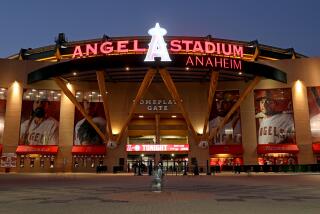An L.A.-friendly football stadium
- Share via
The effort to build a football stadium in downtown Los Angeles is fast approaching its final hearings, as the city’s Planning Commission turns to the issue this week and the City Council prepares to take it up by the end of the month. Those approvals, if granted, will allow Anschutz Entertainment Group to move to the next step: attempting to secure at least one football team and, after that, to begin construction on the property that is today one wing of the city’s much-maligned Convention Center. This is a sound project with clear public benefits, and it should go forward. The city agencies, meanwhile, should use these final talks to ensure that the public interest is maximally protected.
It hardly needs to be said that approving a major project in Los Angeles taxes the patience of all involved. There are political hurdles, potential lawsuits and exhaustive reviews. The final negotiations regarding the football stadium revolve around the project’s environmental impact report, a 10,000-page document that the council members have almost certainly not read. Nevertheless, the report is full of reminders that while this project is good for Los Angeles, it will also create a handful of problems the developer should be required to mitigate.
Take the overlapping issues of traffic and parking. According to the report, AEG is prepared to create 1,112 new parking spaces; that’s a significant investment, but not nearly enough to accommodate crowds estimated to exceed 70,000 on game days. AEG says the rest of the attendees will either park elsewhere downtown or come and go via public transportation. The company is estimating that 20% of patrons will arrive by public transportation, but it has not said much about how it will meet that goal. (By comparison, fewer than 5% of fans who attend Dodger games get there by public transportation.) AEG has offered to pay to expand a nearby subway stop, but the council can and should press for additional improvements that would encourage fans to use buses and subways to attend games. Tickets, for instance, could be bundled with public transportation vouchers, and AEG could be asked to fund special trains, charter services and other improvements that are listed as options in the report but not required.
The stadium project will benefit the entire city. It will create jobs during construction and afterward. It will overhaul the Convention Center, which is struggling to compete with those in cities such as San Francisco, San Diego and Las Vegas. And it will be a magnet for tourists — visitors whose hotel stays, nights out and souvenir shopping will fatten the tax base. But it also will impose burdens on those who live and work nearby, and those burdens will grow as the facility becomes more successful. One football team would mean only a handful of busy Sunday afternoons in the fall — as well as the occasional Monday night — but AEG is courting two, which would double the burden. In addition, AEG imagines the venue hosting the Final Four of college basketball and other major events.
Each of those means traffic congestion, air pollution, inconvenience, expense and, in some cases, displacement. Again, the council’s job in these final talks should be to seek concrete ways to alleviate those impacts. One suggestion that comes from critics of the project would be for AEG to help compensate any downtown residents who are displaced if their housing is destroyed by its owners to make room for lucrative new parking. That seems reasonable, as do proposals that would require AEG to shoulder expenses for security before, during and after events. A promise to end events by a certain hour also could lessen the imposition on surrounding communities.
A stadium necessarily brings some inconveniences. Ask those who live near the Rose Bowl or the Los Angeles Coliseum. That’s not a reason to say no. It is, however, an opportunity to think creatively about what those inconveniences might look like and how the city might address them. To its credit, AEG has heard from scores of community groups across the city in recent months and has incorporated a number of their suggestions into the proposal. Now it’s up to the council to ensure that the final document works in the best interest not just of the developer but of the city as a whole and the communities most affected.
More to Read
A cure for the common opinion
Get thought-provoking perspectives with our weekly newsletter.
You may occasionally receive promotional content from the Los Angeles Times.









